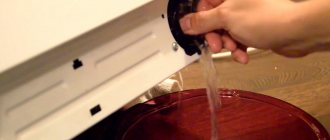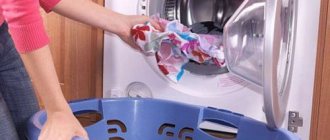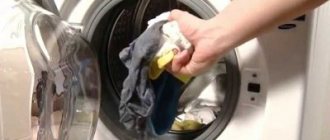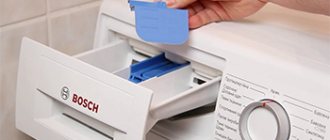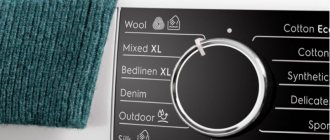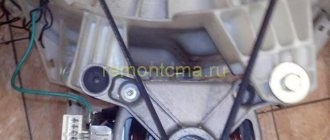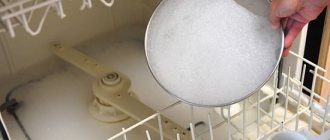You can find out why the washing machine stopped spinning clothes yourself. It is necessary to exclude the possibility of errors in the operation of equipment. Sometimes the reason for the lack of spinning is that the washing mode is set incorrectly. Delicate cleansing is often carried out without twisting; accordingly, when such a program is selected, the spin cycle does not start. If the problems did not appear due to non-compliance with the norms for using the machine, the reason should be sought in technical malfunctions. It is not recommended to remove them yourself. Incompetent intervention in the operation of the device can lead to serious damage; restoring the unit will be expensive.
“Simple” errors are eliminated without repair
Let's look at common faults that you can identify and fix yourself, without the help of professionals. These are problems that arise when equipment is used incorrectly.
Wrong choice of washing mode
The washing machine has washing programs where the spin mode is not provided. For example, “silk”, “delicate wash”, “wool”. After the end of the main process in these modes, the water is drained without spinning the laundry.
More detailed information about the cycles included in each program can be found in the operating instructions. The problem is easy to solve - you need to select the normal washing mode and adjust the number of revolutions.
Overload or uneven distribution of laundry in the drum
If you exceed the volume of items that each washing machine model is designed for, this will lead to disruption of operating modes. Drum overload is a common problem with top-loading machines.
The same difficulty can arise due to uneven distribution of laundry in the drum. During the washing process, things will clump together. At high speeds, an imbalance occurs in an overloaded drum, and the control module sends a signal to end the process without spinning.
Empty the machine of excess laundry and distribute the remaining items evenly.
Signs of problems with spinning
The main sign of a malfunction in the spin system of a washing machine is wet laundry that is removed from the drum after the end of the cycle. Don’t immediately think that the unit is broken. Often the reason is an error in its operation due to setting the wrong mode.
There is no need to rush to get your laundry out of the machine. You should restart the program, making sure that the mode is set correctly and all parameters are set. Some models of washing machines allow you to simply repeat the spin cycle - this function can also be used. If the system fails and the program does not start, you need to look for the cause of the malfunction.
Main defects and solutions
There are many reasons why a washing machine does not spin clothes. If you have checked all the options, but the machine still does not go into spin mode, then start diagnosing the parts.
Drain pump malfunction
The drain pump (pump) is one of the main technical components. It maintains the required water level at all stages of washing and facilitates its drainage from the tank. It is located at the bottom of the unit under the tank. If the pump fails, the machine stops draining water, and as a result, the laundry does not spin.
Before you start disassembling the pump, you need to determine what has failed: the electrical or mechanical part.
The main reasons why the drain pump may fail.
- The coarse filter equipped with the drain pump is clogged.
It is located on the front body in one of the corners of the bottom. If you regularly wash woolen items without checking the pockets for small items, the filter can become clogged with debris and become very dirty. It must be checked constantly. There is usually a handle with which the filter can be unscrewed, removed and washed with water.
- The impeller is jammed; it is located immediately behind the filter.
During rotation, threads, wool, etc. may become wrapped around it. If you find debris blocking operation, then clean it.
You also need to check the rotation of the impeller; it should spin jerkily. If the blades move freely, the part must be secured more tightly.
- Problems with the drain hose.
We carefully check whether there are any blockages inside the hose, as well as its position - so that there are no kinks, remove it and rinse it under pressure of hot water.
If after cleaning and checking the problem is not resolved, then the drain pump requires repair. In this case (in the absence of special repair skills), it is better to seek the help of a specialist.
Failure of the pressure switch
The water level sensor (pressure switch) sends a signal to the controller about the presence or absence of water in the drum. Typically the sensor is located at the top of the side wall.
How to check the performance of the pressure switch.
- Turn off the power to the washing machine.
- Open the panel and unscrew the sensor, disconnect the pressure hose.
- Check the pressure pipes for blockages and flush if necessary.
- Conduct a visual inspection of the sensor (there should be no damage or formations).
- Inspect and, if dirty, clean the contacts.
- Install a silicone tube in place of the removed hose and blow strongly into it.
- If the sensor is working properly, then when the relay is activated, characteristic clicks will be heard.
If the pressure switch is faulty, it must be replaced. Installing a new sensor yourself is not difficult.
Electronic module problem
The most complex and expensive part of the mechanism is the electronic module; it is the one that monitors the operation of all processes and sensors. If it is faulty, it needs to be replaced or the entire system needs to be flashed.
Main reasons for failure:
- power surges;
- manufacturing defects;
- moisture ingress.
To diagnose the cause, it is better to give the control module to a specialist so that he can test the device.
Motor failure
The performance of the motor may be impaired due to inter-turn short circuit of the windings or wear of the graphite brushes. As a result, it will be able to rotate the drum only in washing mode (there will not be enough power for the maximum number of revolutions). The problem is solved by repair or replacement. A complete diagnosis can be carried out at a service center.
Faulty speed control sensor
The tachometer monitors the rotor speed of the electric motor, i.e. the number of drum revolutions per minute. Sensor malfunction is quite rare, mainly due to the coil being misaligned due to a loose screw.
It is necessary to check the wires, fastenings, contacts and fix the coil. If the problem is in the device itself, then it needs to be replaced.
Possible causes of noise and troubleshooting
In addition to poor-quality spinning or its complete absence, equipment can signal a breakdown in another way, namely, by making unusual loud sounds - noise, humming, ringing, etc.
The following recommendations will help you figure out what the cause may be and how to eliminate it.
Problem #1 - shipping bolts not removed
After the selected equipment is delivered home, buyers, as a rule, save on the cost of installing the machine and deal with the procedure themselves.
Connecting the product to the water supply and sewer system is quite simple. But they forget to remove the mounting bolts that secure the drum during transportation.
If the transport bolts are not removed, then when you first start the washing machine it starts to make a loud noise.
After discovering this problem, you should unscrew the remaining bolts and check the operation of the equipment again.
Problem #2 - foreign objects in the drum
When placing items to be washed in the drum, it is imperative to check for various items in your pockets - keys, coins, receipts or receipts.
When they get into the drum or tank of the machine, you can hear a tapping sound.
Objects that fall into the machine can cause serious damage to it and damage some parts. Moreover, small elements often fall into the holes of the drum, after which they are difficult to get out
Also, items that are decorated with metal rivets, large zippers with fasteners, chains, etc. can make noise when washing. To prevent them from knocking on the drum, you should turn the items inside out and then just place them in the washing machine.
Problem #3 - wear of the bearings in the machine
The drum in the washing machine rotates thanks to bearings. If parts are damaged, the drum stops rotating correctly and makes uncharacteristic noise.
To check whether this is the cause, you need to rotate the empty drum from side to side. When bearings wear out and fail, they prevent free rotation and play is felt. During washing, the equipment makes a lot of noise and may vibrate.
Most often, damage to parts is caused by wear of the oil seal: streaks of rust may appear on the machine. They can be seen if you remove the back cover from the product body.
If the cause is correctly determined, the bearings should be replaced.
To do this you will need to perform the following list of actions:
- Disconnect the washing machine from the sewer, water supply, and turn off the power.
- Disassemble the rear and top panels according to the instructions.
- Remove the dispenser and control unit by unscrewing the screws.
- Loosen the clamp, remove the counterweight, heating element, pipes and other parts that prevent access to the engine.
- Remove the motor.
- Remove the drum tank.
- Unscrew the drum to remove the pulley and unscrew the shaft.
- Knock out the bearing using a special tool - a knockout.
- Replace the seals.
- Install the new bearing into the seat.
- Reassemble the equipment in reverse order.
It is better to coat the tank connection points with a sealant. For convenience and to remember the order of the procedure, all steps taken can be recorded using photos or videos.
Problem #4 - problems with drum mounting
A characteristic sign of a weakened pulley is the presence of a click when the drum rotates. The identified problem is resolved quickly enough. Disassembling the washing machine is performed in the same manner as when replacing bearings.
You can tighten the pulley using a specially selected wrench - you need to fix the loose fasteners. For greater reliability, the bolt should be treated with sealant
After completing the procedure, you will need to check whether the washing machine makes noise during the spin cycle. It is better to run a short wash program with twisting to make sure it works correctly.
Problem #5 - Tank counterweights are poorly secured
In order to hold the tank while washing, the machine is equipped with counterweights. If you hear a loud noise during operation, you should check whether the fastenings of this unit are loose.
The bolts may become loose as a result of using the machine for a long time, and a new product may have a manufacturing defect. In the latter case, the equipment is subject to warranty repair.
If the unit fails, you will need to remove the panels of the machine and unscrew all the parts that prevent free access to the counterweights. Next, you need to check their integrity and secure the fastenings more tightly.
Problem #6 - Incorrect installation
When installing a washing machine, users do not always pay attention to the quality of the floor surface and the presence of unevenness on it.
As a rule, tiles are quite slippery and the machine can move on the floor. To do this, you need to glue rubber tips to the legs if they are missing.
The equipment should be installed according to the instructions, using a level or glass of water. If the surface is uneven, you can place a flat surface made of wood or other dense material under the washing machine.
Stores also sell special rubber installation mats.
Problem #7 - high noise level of a specific model
Increased noise levels may not cause any damage. Some budget cars are very noisy.
When purchasing a product, you should definitely be interested in this characteristic. The indicator in the equipment passport is indicated in dB. Quieter models do not exceed 54 dB during washing and 65 dB during twisting.
Some models of machines with a direct drive type - inverter washing machines - have a low noise level.
If a problem with increased noise is detected, you must check the product specifications specified in the documentation.
Washing machine problems and solutions
What to do if the spin mode does not work
If the washing machine does not complete the last cycle, then you must:
- Check the washing mode selection. An explanation for each program is in the operating instructions.
- Avoid imbalance of laundry in the drum. Control the weight and distribution of things inside.
- Restart the program - a failure may have occurred.
- Conduct diagnostics of the main components.
The washing machine does not spin well
The main reason is that the water does not completely leave the tank, but the water level sensor does not send a signal about its presence. In such cases, it is necessary to inspect the drain pipe, hose and filter for blockages.
- Clean the drain filter and hose.
- Check that the drain hose is positioned correctly.
- If this does not help, remove the drain pipe between the pump and the drum and clean it of dirt.
Why doesn't the spin mode turn on?
If switching to spin mode does not occur in different washing options, the reasons may be:
- failure of the heating element;
- failure of the programmer and control module.
Spin mode does not turn off
A typical problem is when the machine does not turn off the program and does not stop washing.
- The water discharge valve is clogged and the speed control sensor is malfunctioning.
- Failure of the water heating element.
- The filter is clogged (the water circulation is disrupted and there is no signal to reset or complete the cycle).
- Incorrect operation of the electronic unit.
No spin
If you have to take completely wet laundry out of the machine, this does not always mean that it’s time to get upset and prepare for the costs of repairing the washing machine. Modern models are equipped with many automatic protection systems. Therefore, the case when the spin does not work may not be caused by physical breakdowns of the mechanics or electronics. This is often due to user errors or obvious violations of the device operating rules.
- The housewife loads an excessive amount of laundry into the machine. The loading volume of the model is always indicated in the instructions for its use. And if you load more into the drum, it will simply stop. This is standard protection that is present in modern models and prevents engine overload.
- An error was made when selecting the washing mode. For example, many washing machines have the option of so-called delicate processing of laundry or hand washing. In these cases, spinning is not provided or is performed at very low speeds. As a result, wet laundry has to be removed from the drum. There is only one piece of advice: you need to choose the right washing mode before starting the machine.
- If the washing machine is controlled by mechanical buttons, the lack of spinning may be due to the accidental pressing of the corresponding switch, which turns it off. The same situation occurs when the contact groups of the control panel are excessively dirty.
- There are too few things in the drum. In this case, the sensors of modern models detect imbalance during rotation, and the machine stops spinning. This prevents damage to the mechanical parts of the drive and drum.
Rarely, a non-working spin cycle is associated with a broken pump. In this case, the machine runs the cycle normally. But due to the lack of water pumping, the laundry remains wet. However, this situation is very rare. Modern machines detect a pump malfunction, display errors or refuse to start the wash cycle.
Malfunctions requiring specialist assistance
There are some malfunctions that it is not recommended to fix on your own without special training and knowledge. There is a high probability of damage to other elements.
What to entrust to the service center masters:
- tachometer repair;
- diagnostics of pressure switch;
- engine repair;
- reflashing the control module or replacing the stabilizer.
In the video, the author explains how to solve the spin problem in an Indesit brand washing machine.
What can you do before calling a specialist?
Users who are forced to remove wet laundry from washing machines can conduct partial and complete diagnostics of the device. Some problems can be resolved without contacting a service center. Simple checks are done first.
- The set washing mode is checked. If it does not provide spinning, you should choose another program or set the correct number of revolutions for the mode.
- Make sure that there is not an excessive amount of laundry loaded into the machine. If you can’t determine its mass by eye, you should pull out a part and try to start the wash again.
- Check if the drum is unbalanced when there is a small amount of laundry. If it has gathered into one compact pile, it is worth distributing the contents over the walls in an even layer.
If simple measures do not help, a full diagnosis is carried out, starting with simple causes. First, unscrew the drain hose from the back of the machine. The filters are checked, as well as the pipe. If necessary, cleaning is carried out and parts are reinstalled.
Checking the tachometer will require disassembling the machine. The knot must be tightly fixed. If necessary, tighten the fasteners. The condition of the wiring and contacts is also checked. Damaged lines are replaced with solid sections of cable, connections are soldered, and areas are cleaned.
If the brushes are worn out or the motor is damaged, the machine may not be able to spin properly. The motor is removed. The unit checks the installation of the tachometer and the condition of the brushes. If the latter are worn out, they are replaced. It is also worth ringing the coils and replacing the engine if a malfunction is detected. However, such work is only available to users with the appropriate level of knowledge.
Preventive measures
By following the basic rules and operating recommendations, you can partially avoid damage to your washing machine.
- Periodically rinse the dispenser to remove any residual detergent.
- Do not overload the machine with laundry.
- Before washing, check all pockets and remove small parts that may clog the filter.
- Pour detergent strictly according to the norm; excess may accumulate in the dispenser and clog the grate.
- After each wash, wipe the rubber cuff of the hatch with a dry cloth.
- Maintain intervals between washes of 1-2 hours.
If you notice malfunctions and find a malfunction, immediately fix it. Remember: operating such a unit is prohibited and dangerous to life.
You may need to contact service
If the machine spins poorly, when should it be repaired?
If preventive measures and repairs on your own do not help and the machine does not spin well, then it must be inspected by a professional. In these cases, you will definitely need to contact the service for help:
- software problem;
- engine malfunction;
- bearing wear;
- pump replacement.
Problem with the tachometer
The tachometer is located on the engine and fails when the machine is frequently overloaded and operated at the limit. This device monitors the number of revolutions, and if the tachometer does not work correctly, then the spin speed cannot be correctly set by the “brain” of the machine and, as a result, it spins poorly.
There may be a problem with the contacts of the tachometer and it becomes necessary to check the fastening, wires and contacts.
It is easy to check the functionality of the part. This type of breakdown is characterized by unchanging and inadequate drum rotation speed. If the sensor breaks down, it needs to be replaced with a new one.
How to replace the sensor?
- The rear wall of the car is removed.
- The drive belt is removed.
- The tachogenerator is removed from the engine.
- A new part is bought and installed in place of the old one.
- The repair ends with putting on the belt and screwing the back cover.
Engine malfunction
The motor is located under the body of the washing machine and will have to be removed.
To do this, you need to disconnect the wires, the belt, and unscrew the part.
The purpose of all these actions is to identify the malfunction: remove the brushes, tachometer, check the coils.
The brushes inside the engine are subject to wear and this reduces its power.
As a result, the number of revolutions is disrupted due to lack of strength and the washing machine does not spin out the laundry well.
Fault in the control board
The problem with the board (module) most likely cannot be identified on your own!
The module is the brain of the machine. It controls all processes, programs, sensors, etc.
The repair will not be cheap, the module is an expensive part, it costs about 1/3 of the price of the car and it is better if the repair is carried out by a professional.
If there is such a reason, the following manifestations are characteristic:
- machine freezing;
- indiscriminate program changes;
- alternate blinking of indicators;
- washing cannot be completed.
Incorrect loading of the machine
Washing machines react negatively to both the large weight of clothing and its shortage. The automatic machine works in such a way that after activating the washing process, it “distributes” the load.
The drum rotates according to a specific beat, all loaded laundry is evenly spread over the cylinder, distributing the weight. At the same time, water is collected. When the mass of pawned clothing is very small, or it has gathered in a heap, a special sensor reacts. Therefore, the washing machine does not spin. These reasons trigger automatic protection of the machine, since at maximum speed the drum will experience an unacceptable level of load. But the same factor serves as the basis for turning off the machine when it is overloaded with clothes.
How to avoid breakdown
It is always better to prevent a breakdown than to repair it later. Moreover, the operating rules are simple:
- Before loading laundry into the drum, check all pockets and remove foreign objects.
- Install and connect the machine correctly according to the instructions.
- Sort your items before washing. Place clothes with decorations in special bags.
- Do not load too much laundry. This leads to rapid wear of the washing machine and poor quality washing.
- Install a voltage stabilizer. It will protect expensive equipment from sudden breakdown.
- Clean the drain filter and detergent dispenser periodically.
- Do not close the hatch door after removing the laundry. This promotes the formation of fungus and mold.
Now you know why the drum in a washing machine may not spin and wring out clothes. Be attentive to the first signs of damage, then you will be able to avoid expensive repairs.
How to clean the drain filter
Cleaning the filter should be done in stages. The procedure requires the following steps:
- Turn off the water supply and disconnect the equipment from the power supply. This is necessary for safety reasons so as not to receive an electric shock.
- Open the hatch cover under which the filter is located. In some models, the filter is located under the false panel at the bottom of the case.
- Drain the remaining water from the tank. It is important to be prepared that water may start to pour out, so you should take a basin or a rag.
- Unscrew and remove the catch filter.
- Remove large debris and foreign objects from the filter. Having removed the main dirt, all that remains is to clean the filter with a regular sponge with a hard surface, and then rinse under high water pressure.
- Secure the filter to its original position. The part should be positioned evenly, without distortions.
Prevention
Regular maintenance helps reduce the risk of malfunction. For reliability, it is worth using a set of measures.
Checking pockets before washing
Foreign objects often become clogged in the filter, causing the spin function to turn off. Pre-checking your clothing pockets will eliminate the need to frequently clean the filter.
Washing powder quality
Poor quality powder negatively affects the condition of internal mechanisms. Using proven powders, you will be able to save on equipment repairs.
Network filters
Using a surge protector protects the washing machine from sudden power surges and short circuits. The surge protector turns on automatically and does not consume a large amount of resources.
Periodic cleaning of the machine
By periodically cleaning the filter and drum, you will be able to get rid of accumulated dirt in a timely manner. The ability to carry out cleaning yourself simplifies the maintenance of the machine.
